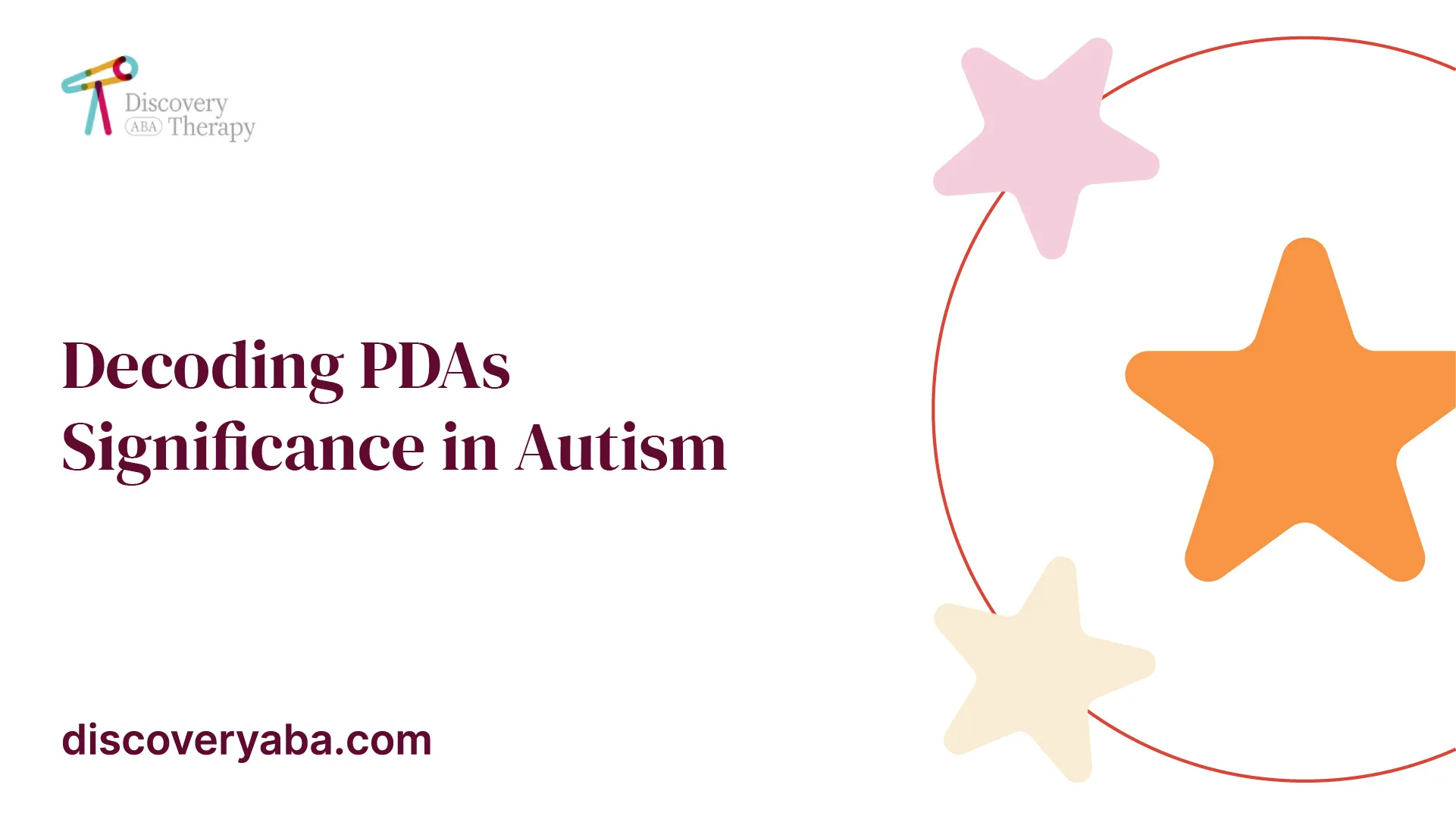Decoding PDAs Significance in Autism
Unraveling PDA in autism: Understand its significance, characteristics, and tailored support for individuals.

Understanding PDA in Autism
To fully comprehend the significance of Pathological Demand Avoidance (PDA) in the context of autism, it is essential to explore what PDA is, its characteristics, and its relationship to autism.
What is PDA in Autism?
PDA, which stands for Pathological Demand Avoidance, is a profile that is considered part of the autism spectrum. It is characterized by extreme demand avoidance, anxiety, and a strong need for control. Individuals with PDA often have a distinct way of responding to demands and expectations, which sets them apart from other individuals on the autism spectrum.
Characteristics of PDA
People with PDA often experience high levels of anxiety, which can manifest in explosive outbursts, meltdowns, and avoidance of demands. They may exhibit a strong need to be in control of situations and may struggle with flexibility and transitions. Difficulties with social communication and interaction, similar to other individuals on the autism spectrum, are also commonly observed in individuals with PDA [1].

PDA as a Subtype of Autism
While PDA is not currently recognized as a separate diagnostic category in most countries, there is a growing understanding and awareness of PDA as a distinct subtype of autism. Research in this area is still in its early stages, indicating that our understanding of PDA is evolving. However, it is widely accepted that PDA represents a unique profile within the broader autism spectrum.
Recognizing and acknowledging PDA as a subtype of autism is crucial for ensuring that individuals with PDA receive appropriate support and accommodations tailored to their specific needs. By understanding the characteristics and challenges associated with PDA, we can work towards creating a more inclusive and supportive environment for individuals on the autism spectrum.
Diagnosis and Support for PDA
Understanding and recognizing Pathological Demand Avoidance (PDA) in individuals on the autism spectrum is crucial in providing appropriate support and accommodations tailored to their needs. While PDA is not currently recognized as a separate diagnostic category in most countries, awareness of PDA as a subtype of autism is growing. In this section, we will explore the recognition and diagnosis of PDA, as well as tailored support and education for individuals with PDA.
Recognizing and Diagnosing PDA
Recognizing and diagnosing PDA can be challenging due to its unique characteristics. PDA individuals often exhibit extreme demand avoidance, anxiety, and a strong need for control. However, it is important to note that PDA is considered to be a part of the autism spectrum, with individuals exhibiting additional challenges specific to PDA.
Diagnosing PDA typically involves a comprehensive assessment conducted by professionals experienced in autism diagnosis. This assessment may include observations, interviews, and questionnaires that gather information about the individual's behavior, communication, and interactions. The Autism Diagnostic Observation Schedule (ADOS) and the Diagnostic Interview for Social and Communication Disorders (DISCO) are commonly used tools to aid in the diagnosis of PDA.
Tailored Support for Individuals with PDA
Support for individuals with PDA should be tailored to their specific needs and challenges. Traditional strategies used for individuals with other autism profiles may not be as effective for those with PDA. Flexibility, individualized approaches, and reducing demands are key factors in supporting individuals with PDA effectively.
Education and awareness about PDA are essential for parents, educators, and professionals working with individuals with PDA. By understanding the unique characteristics and challenges associated with PDA, appropriate support and accommodations can be provided to help individuals thrive in various environments.
Education and Accommodations for PDA
In educational settings, individualized Education Programs (IEPs) play a crucial role in supporting individuals with PDA. IEPs provide personalized plans that outline specific goals, accommodations, and services tailored to the individual's unique needs. These programs encompass academic, behavioral, and social-emotional objectives and are developed collaboratively by a team consisting of parents, educators, and professionals.
Accommodations in educational settings may include providing visual supports, breaking tasks into smaller steps, allowing additional processing time, and reducing sensory stimuli to help individuals with PDA manage their anxiety and avoid overwhelming demands. Creating a structured and predictable environment can also be beneficial.
By recognizing and understanding PDA as a subtype of autism, individuals with PDA can receive the appropriate support and accommodations they need to thrive. Education, awareness, and tailored interventions are crucial in providing effective support for individuals with PDA and enabling them to reach their full potential.
Coping Strategies for PDA
Individuals with Pathological Demand Avoidance (PDA) can benefit from the implementation of coping strategies tailored to their specific needs. These strategies aim to assist both children and adults with PDA in managing their daily challenges and improving their overall well-being. Here, we explore helpful approaches for children with PDA, coping strategies for adults with PDA, and the importance of building a supportive community.
Helpful Approaches for Children with PDA
When supporting children with PDA, it is crucial to adopt a flexible and individualized approach. There is no one-size-fits-all solution, as each child with PDA has unique needs and preferences. Helpful approaches for children with PDA should be tailored to the individual child, applied flexibly, and reviewed regularly.
It is recommended to learn as much as possible about PDA and explore various resources such as webinars, books, social stories, and games that cover helpful approaches for children with PDA. These resources can provide valuable insights and guidance, although they may require creative adaptation to be effective with PDA children.
Some helpful approaches for children with PDA include optimizing the environment, emphasizing negotiation and collaboration, and promoting flexibility. These approaches may also benefit individuals with other presentations/conditions or those experiencing heightened emotional states or extreme anxiety.
Coping Strategies for Adults with PDA
Adults with PDA often face unique challenges and may employ coping strategies to manage their condition. One common coping mechanism is masking, which involves hiding PDA traits to appear more socially acceptable. However, masking can have negative consequences and may lead to burnout.
Successfully managing demands, which can be overwhelming for individuals with PDA, involves various coping strategies. These strategies may include breaking down tasks into smaller parts, planning downtime, and reducing unnecessary demands to maintain a manageable level of anxiety. Individuals with PDA may also employ techniques such as distracting themselves from tasks, 'bursting' demand avoidance through excitement, or giving themselves an 'out' to change their mind when needed [5].
Building a Supportive Community
Finding a supportive community of individuals who understand PDA can be instrumental in providing reassurance and a sense of liberation. Support groups, books, blogs, and social media platforms play a vital role in creating this sense of connection among individuals with PDA. Sharing experiences, insights, and strategies with others who can relate to the challenges of PDA can foster a supportive and understanding environment.
By implementing helpful approaches and coping strategies, both children and adults with PDA can navigate their daily lives more effectively. It is important to remember that there is no right or wrong way to handle PDA; understanding the individual's needs, learning about PDA, and adapting approaches accordingly are key to supporting individuals with PDA.
Treatment and Therapy for PDA
Individuals with Pathological Demand Avoidance (PDA) in the context of autism often benefit from various treatment and therapy options. These interventions aim to support individuals in managing their specific challenges and enhancing their overall well-being. Three key approaches commonly utilized for individuals with PDA are Individualized Education Programs (IEPs), Cognitive Behavioral Therapy (CBT), and Speech and Language Therapy (SLT).
Individualized Education Programs (IEPs)
Individualized Education Programs (IEPs) play a crucial role in supporting individuals with PDA in educational settings. These programs provide personalized plans that outline specific goals, accommodations, and services tailored to the individual's unique needs. The IEP team, which typically includes parents, educators, and professionals, collaboratively develops strategies to promote learning and regulate anxiety. IEPs encompass academic, behavioral, and social-emotional objectives and are designed to ensure that the individual receives the necessary support to thrive in the educational environment.
Cognitive Behavioral Therapy (CBT)
Cognitive Behavioral Therapy (CBT) is a widely used therapeutic approach for individuals with autism and PDA. This therapy focuses on identifying and modifying unhelpful thoughts, emotions, and behaviors to help individuals develop coping strategies, improve problem-solving skills, and enhance emotional regulation. CBT aims to provide practical tools and strategies for individuals to navigate demands and challenges effectively. By helping individuals understand and manage their responses to different situations, CBT empowers them to better regulate their behavior and emotions.
Speech and Language Therapy (SLT)
Speech and Language Therapy (SLT) is another essential component of treatment for individuals with PDA. SLT aims to improve verbal and nonverbal communication skills, social pragmatic abilities, and overall language development. Through individual or group sessions, speech and language therapists work with individuals with PDA to build vocabulary, enhance conversational skills, and improve social communication. Visual supports, social stories, and role-playing activities may be utilized to facilitate learning and practice of effective communication strategies.
By combining these various treatment and therapy options, individuals with PDA can receive comprehensive support tailored to their specific needs. The goal is to help individuals with PDA develop the necessary skills to navigate demands, regulate their responses, and lead fulfilling lives within their unique strengths and abilities. It is important to note that treatment and therapy should always be individualized, taking into account the specific needs and preferences of each person with PDA.
References
- https://neurodivergentinsights.com/autism-infographics/autism-pda-explained
- https://www.pdasociety.org.uk/what-is-pda-menu/about-autism-and-pda/
- https://www.pdasociety.org.uk/life-with-pda-menu/family-life-intro/helpful-approaches-children/
- https://www.pdasociety.org.uk/life-with-pda-menu/adult-life-landing/self-help-coping-strategies-and-therapies-for-adult-pdaers/
Does Your Child Have An Autism Diagnosis?
Learn More About How ABA Therapy Can Help
Find More Articles
Contact us
North Carolina, Nevada, Utah, Virginia
New Hampshire, Maine
Arizona, Colorado, Georgia, New Mexico, Oklahoma, Texas
.avif)




































































































